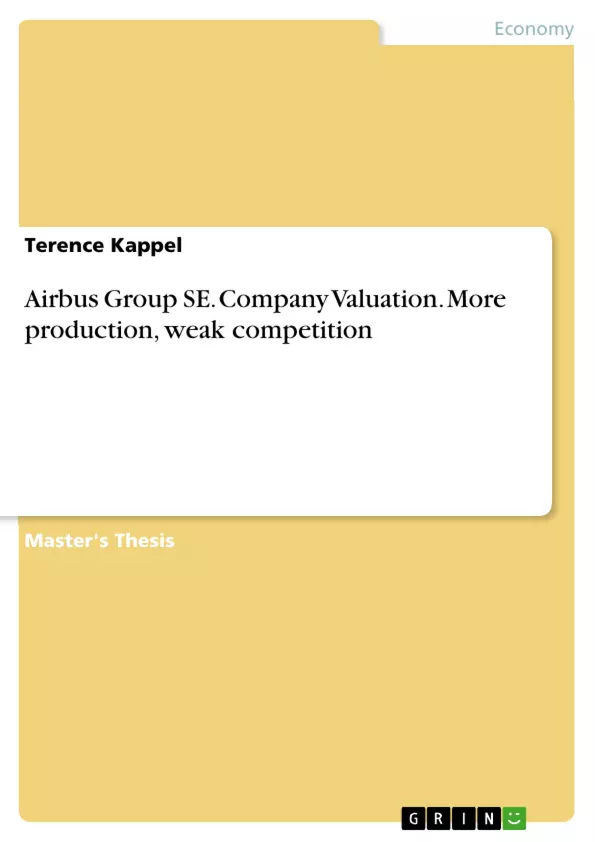Company report. Airbus Group SE. More production – weak competition. With a major backlog into the downturn of the market.
The Airbus Group is the second largest Aerospace Company in the world in regards to aircrafts produced. In addition to obtaining 70% of revenues from Civil Aircrafts, Airbus is also active in Defence & Space (20%) and Helicopter (10%). It is present in all major countries with sales and service points but producing only in France, Germany, Spain, UK, China and the US.
The Airbus Group SE consists of three operating business units: Civil Aircrafts, Defence & Space and Helicopters. Each will be presented individually in the following paragraphs [...]
Inhaltsverzeichnis (Table of Contents)
- Company overview
- CIVIL AIRCRAFTS
- DEFENCE & SPACE
- HELICOPTERS
- Management & Governance
- ORGANISATIONAL STRUCTURE
- SHAREHOLDERS
- GROWTH STRATEGY
- RESTRUCTURING PLANS
- WTO
- Industry overview
- MACROECONOMIC CONTEXT
- PRODUCT & REGIONAL TRENDS
- COMPARABLE COMPANIES
- Valuation
- MAIN VALUE DRIVERS FORECAST
- COST OF CAPITAL
- SUM-OF-PARTS VALUATION
- Multiple Valuation
- Sensitivity Analysis
- Annexes
Zielsetzung und Themenschwerpunkte (Objectives and Key Themes)
This report provides a comprehensive analysis of Airbus Group SE, a leading aerospace company, with a focus on its financial performance and future growth prospects. The report aims to provide a detailed overview of the company's business operations, its key value drivers, and a valuation analysis based on various financial models.
- Civil Aircraft Market Dynamics
- Competition and Market Share Analysis
- Production Capacity and Growth Strategies
- Valuation and Financial Performance
- Defence & Space and Helicopters Business Units
Zusammenfassung der Kapitel (Chapter Summaries)
The report commences with a detailed company overview, dissecting each of Airbus Group's primary business units: Civil Aircrafts, Defence & Space, and Helicopters. The Civil Aircrafts segment, comprising 70% of the group's revenue, is extensively examined, highlighting the critical role of the A320 family, the A330, the A350, and the A380 in the company's overall performance. The report then delves into the dynamics of the defence and space business, outlining the key products and market trends. Finally, the report explores the helicopters division, focusing on its market position and key competitors. Subsequently, the report delves into the broader industry overview, including a discussion of the macroeconomic context, product and regional trends, and a comparative analysis of Airbus with other major aerospace companies. The report concludes with a comprehensive valuation analysis, encompassing a forecast of key value drivers, a cost of capital analysis, and a sum-of-parts valuation, along with multiple valuation and sensitivity analyses.
Schlüsselwörter (Keywords)
This report explores key concepts within the aerospace industry, particularly focusing on the civil aircraft sector. The report delves into the financial performance and future growth prospects of Airbus Group SE, examining crucial aspects such as production capacity, market share analysis, competitive landscape, and valuation methodology. The report also investigates the company's strategies for navigating macroeconomic trends and its position within the broader defence and space, and helicopters segments.
- Arbeit zitieren
- Terence Kappel (Autor:in), 2017, Airbus Group SE. Company Valuation. More production, weak competition, München, GRIN Verlag, https://www.grin.com/document/385360



